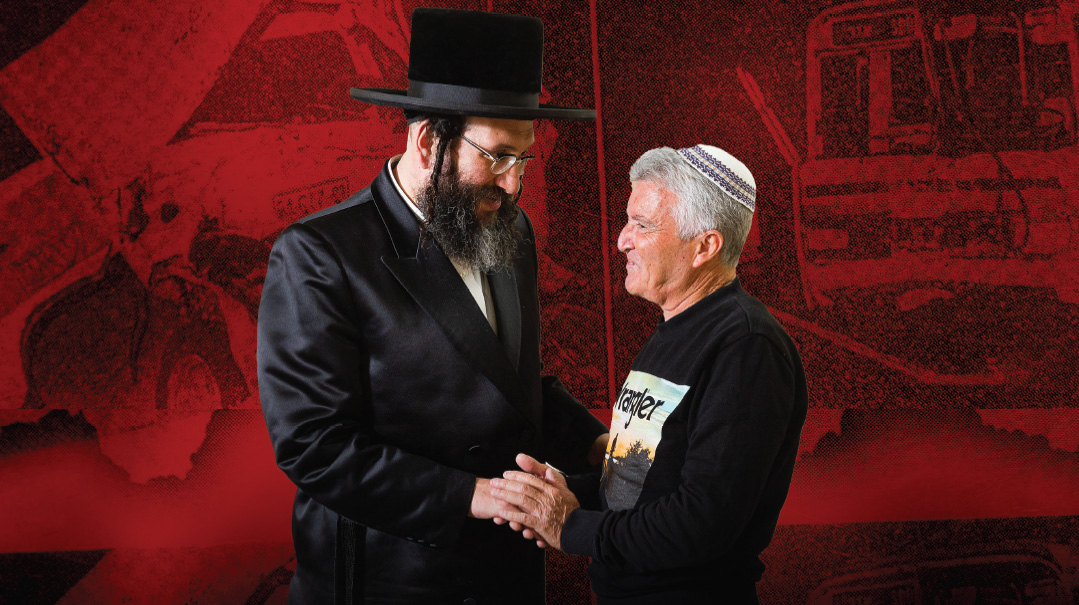For This Child We Prayed
| April 25, 2023Rebbe Abish Meir of Spinka meets the medic who saved his life

Photos: Elchanan Kotler
He was just ten years old when it happened, the horrifying car crash that took the lives of four rabbanim, including Rebbe Abish Meir’s own father, on the way back from the Baba Sali’s funeral 39 years ago. Three months after he was nearly left for dead, and having defied every medical prognosis, little Abish Meir stood up on his battered, shaky legs for the first time.
ITwas a rainy Sunday, 4 Shevat, 1984, and Shimon Yifrach’s shift as an ambulance driver for the Maged David Adom station in Ashdod’s Rova Daled had been pretty routine. It had been a stressful day for all emergency personnel: The holy 94-year-old Baba Sali — Rav Yisrael Abuchatzeira — had passed away the night before, and thousands upon thousands converged on his funeral in the southern town of Netivot. But so far there were no emergencies, and he hoped he’d get through the evening without too much excitement.
“But then the dispatcher’s voice came to life,” Shimon Yifrach remembers. “There had been a terrible accident on the highway that runs from Ashkelon to Bnei Brak just outside the Ashdod interchange, and when I asked for more information, she screamed, ‘Just go, just go!’ I immediately jumped into the ambulance with another volunteer and sped as fast as I could in the pouring rain with lots of fog, poor lighting and little visibility. On the way I was updated — a crash between a private car and an Egged bus. When I got to the scene of the accident, I saw a bus on the side of the road surrounded by several cars that had stopped, and dozens of people screaming and praying. All of them, including the mangled car, I’d later learn, were on the way back from the Baba Sali’s funeral.”
Today the highway has a proper meridian and better lighting, but at the time, there was just a lane divider that essentially disappeared in the fog. Apparently the Subaru driving in the direction of Bnei Brak crashed head-on with the fast-moving oncoming bus in the opposite direction. The Subaru didn’t have a chance. It was smashed under the grill of the bus, a crushed mass of metal.
The scene looked hopeless, but Shimon didn’t lose his cool. “It was pitch dark, and the only light I had was from the ambulance’s flashlight. I didn’t think anyone could have survived that crash, but I gently moved inside, somehow managing to open the back door: There were four adult men, mangled and heaped upon one another — to this day I get shivers just thinking about it. But I put myself on autopilot and checked each one — maybe there would somehow be a sign of life, but there was no pulse, nothing.
“And then, in the middle of this horrible carnage, I looked down on the floor of the car and couldn’t believe my eyes: Underneath the other bodies was a thin little boy of about 10, lying there covered in blood. I called on some others to help get him out, and ever so carefully we managed to extricate him and get him onto a stretcher. He looked dead, but when I checked him, I felt a pulse — very weak, but still there.”
Shimon worked like a man possessed as he began resuscitation. “I don’t really know why I made the effort. It was clear that the kid didn’t have a chance. It was a lost cause.” When he saw that there was some movement, he put an oxygen mask on his face, loaded him into the ambulance, and began speeding toward Barzilai Hospital in Ashkelon, just a few minutes’ drive away.
“Meet me at the entrance!” he screamed into his radio, connecting to the emergency personnel. If you wait until he comes into the ER, he’ll die in my hands!” A team was waiting outside, took the stretcher, and whisked the child to the trauma unit.
“I did mine, but afterward, I really wanted to find out what happened to this child. Did he live? Would he ever be more than a vegetable? I asked around at Barzilai and my MDA colleagues, but he’d been transferred from Barzilai to Hadassah Ein Karem in Jerusalem, and I never got a straight answer.”
Until he attended a hilula for the Baba Sali in 2008, 24 years later.

Oops! We could not locate your form.







